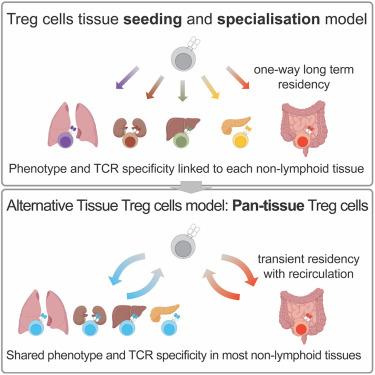Immunity ( IF 25.5 ) Pub Date : 2024-06-18 , DOI: 10.1016/j.immuni.2024.05.023 Oliver T Burton 1 , Orian Bricard 2 , Samar Tareen 2 , Vaclav Gergelits 3 , Simon Andrews 2 , Laura Biggins 2 , Carlos P Roca 2 , Carly Whyte 2 , Steffie Junius 4 , Aleksandra Brajic 4 , Emanuela Pasciuto 5 , Magda Ali 6 , Pierre Lemaitre 4 , Susan M Schlenner 7 , Harumichi Ishigame 8 , Brian D Brown 9 , James Dooley 1 , Adrian Liston 1

|
The tissues are the site of many important immunological reactions, yet how the immune system is controlled at these sites remains opaque. Recent studies have identified Foxp3+ regulatory T (Treg) cells in non-lymphoid tissues with unique characteristics compared with lymphoid Treg cells. However, tissue Treg cells have not been considered holistically across tissues. Here, we performed a systematic analysis of the Treg cell population residing in non-lymphoid organs throughout the body, revealing shared phenotypes, transient residency, and common molecular dependencies. Tissue Treg cells from different non-lymphoid organs shared T cell receptor (TCR) sequences, with functional capacity to drive multi-tissue Treg cell entry and were tissue-agnostic on tissue homing. Together, these results demonstrate that the tissue-resident Treg cell pool in most non-lymphoid organs, other than the gut, is largely constituted by broadly self-reactive Treg cells, characterized by transient multi-tissue migration. This work suggests common regulatory mechanisms may allow pan-tissue Treg cells to safeguard homeostasis across the body.
中文翻译:

组织驻留调节性 T 细胞库是由短暂的多组织迁移和保守的驻留程序形成的
组织是许多重要免疫反应的场所,但免疫系统如何在这些部位进行控制仍然不透明。最近的研究发现,与淋巴 Treg 细胞相比,非淋巴组织中的 Foxp3 +调节性 T (Treg) 细胞具有独特的特征。然而,组织 Treg 细胞尚未被跨组织全面考虑。在这里,我们对全身非淋巴器官中的 Treg 细胞群进行了系统分析,揭示了共有的表型、短暂驻留和常见的分子依赖性。来自不同非淋巴器官的组织 Treg 细胞共享 T 细胞受体 (TCR) 序列,具有驱动多组织 Treg 细胞进入的功能能力,并且在组织归巢方面与组织无关。总之,这些结果表明,除肠道外,大多数非淋巴器官中的组织驻留 Treg 细胞池主要由广泛的自身反应性 Treg 细胞组成,其特征是短暂的多组织迁移。这项工作表明,共同的调节机制可能允许泛组织 Treg 细胞维护全身的稳态。











































 京公网安备 11010802027423号
京公网安备 11010802027423号